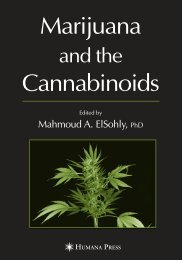Growth characteristics of Cannabis sativa L. cultivated in a ... - NIHS
Growth characteristics of Cannabis sativa L. cultivated in a ... - NIHS
Growth characteristics of Cannabis sativa L. cultivated in a ... - NIHS
You also want an ePaper? Increase the reach of your titles
YUMPU automatically turns print PDFs into web optimized ePapers that Google loves.
18 <br />
er<strong>in</strong>g were periodically observed.<br />
Propagation by cutt<strong>in</strong>gs<br />
The axillary shoot cutt<strong>in</strong>gs <strong>of</strong> female plants (ca. 10 cm <strong>in</strong> length)<br />
both with or without the ma<strong>in</strong> stems were planted <strong>in</strong> soil (12 cm<br />
i.d. pot), and <strong>cultivated</strong> <strong>in</strong> a phytotron as mentioned above.<br />
Field cultivation<br />
The seeds <strong>of</strong> THCA-type were sown 10 cm apart <strong>in</strong> a bed (1.3 m<br />
x 3.7 m), 60 cm ridge width on March 31, 2003. Plant height,<br />
number <strong>of</strong> nodes and flower<strong>in</strong>g were periodically observed. Maximum<br />
length and width <strong>of</strong> the palmate leaf and leaflet, and number<br />
<strong>of</strong> leaflets were determ<strong>in</strong>ed on Aug. 8, 2003.<br />
Results and Discussion<br />
<br />
In a prelim<strong>in</strong>ary experiment, cannab<strong>in</strong>oids contents <strong>in</strong> the leaves<br />
were determ<strong>in</strong>ed. THCA-type conta<strong>in</strong>ed 3.34-7.51% (average<br />
4.76%) dry weight THCA and 0-0.38% dry weight CBDA, whereas<br />
CBDA-type conta<strong>in</strong>ed 5.08% dry weight CBDA without any detectable<br />
THCA. There were differences <strong>in</strong> color and size <strong>of</strong> the<br />
seeds between the THCA-rich and CBDA-rich varieties (Fig. 2A<br />
and B).<br />
The seeds <strong>of</strong> THCA-type were smaller and darker than those <strong>of</strong><br />
CBDA-type. There were also differences <strong>in</strong> germ<strong>in</strong>ation ability.<br />
All the THCA-type seeds germ<strong>in</strong>ated <strong>in</strong> a phytotron while the<br />
germ<strong>in</strong>ation rate <strong>of</strong> CBDA-type was only 39% (Table 1).<br />
Germ<strong>in</strong>ation rate <strong>of</strong> THCA-type was also high <strong>in</strong> a field (83.%).<br />
Table 1. Germ<strong>in</strong>ation and male-flower<strong>in</strong>g <strong>of</strong> cannabis plants<br />
<strong>cultivated</strong> under different environmental conditions<br />
Phytotron conditions: 24 C/14 hr light, 20 C/10 hr dark, and<br />
60% relative humidity. The seeds were sown <strong>in</strong> 2003.<br />
Both varieties grew healthily <strong>in</strong> the phytotron (Fig. 2C and D).<br />
The period to male-flower<strong>in</strong>g <strong>in</strong> the phytotron was 63 days for<br />
THCA-type and 106 days for CBDA-type (Table 1). However,<br />
the period to male-flower<strong>in</strong>g was much longer <strong>in</strong> the field (THCAtype:<br />
155 days). In the field, the daytime length at the time <strong>of</strong><br />
sow<strong>in</strong>g (Mar. 31, 2003) was 12 hr 32 m<strong>in</strong> and it peaked (14 hr 39<br />
m<strong>in</strong>) dur<strong>in</strong>g the summer solstice and then it reduced to 12 hr 57<br />
m<strong>in</strong> at the time <strong>of</strong> male-flower<strong>in</strong>g (Sep. 2, 2003). On the other<br />
hand, the light period was constant at 14 hr <strong>in</strong> the phytotron; that<br />
might be one <strong>of</strong> the reasons for much shorter period to male-flower<strong>in</strong>g<br />
<strong>in</strong> the phytotron.<br />
<strong>Growth</strong> <strong>characteristics</strong> such as plant height, number <strong>of</strong> true<br />
leaves, number <strong>of</strong> nodes and number <strong>of</strong> axillary buds were compared<br />
between THCA-rich and CBDA-rich varieties (Table 2).<br />
All the values <strong>of</strong> the THCA-type were larger than those <strong>of</strong> the<br />
CBDA-type dur<strong>in</strong>g the observation period. The THCA-type plants<br />
grew to an average height <strong>of</strong> 125.8 cm and bore fruits after 75<br />
days <strong>of</strong> cultivation. On the other hand, CBDA-type reached 114.7<br />
cm <strong>in</strong> height and male-flowered after 106 days <strong>of</strong> cultivation. F<strong>in</strong>al<br />
numbers <strong>of</strong> true leaves (38.0) and nodes (21.0) <strong>of</strong> CBDA-type<br />
were comparable to those <strong>of</strong> THCA-type (37.7 and 20.8, respectively).<br />
However, there was significant difference <strong>in</strong> axillary bud<br />
formation (24.0 for THCA-type and 17.5 for CBDA-type). These<br />
growth and germ<strong>in</strong>ation differences between the two varieties<br />
might be attributed to the genetic variation that has been reported<br />
previously 6-8, 10) .<br />
Propagation by cutt<strong>in</strong>gs<br />
'Drug type' (THCA-rich variety) plants have been experimentally<br />
propagated by cutt<strong>in</strong>gs 11) . As female plants are <strong>of</strong> importance for<br />
drug production 1) , the axillary shoot cutt<strong>in</strong>gs <strong>of</strong> female THCAtype<br />
were prepared and planted <strong>in</strong> soil. Root<strong>in</strong>g rates <strong>of</strong> the cutt<strong>in</strong>gs<br />
either with or without the ma<strong>in</strong> stem are shown <strong>in</strong> Table 3.<br />
Plant establishment <strong>of</strong> the cutt<strong>in</strong>gs with the ma<strong>in</strong> stem was much<br />
easier than those without the ma<strong>in</strong> stem. The plant heights are<br />
presented <strong>in</strong> Table 4.<br />
After 94 days, the plants derived from cutt<strong>in</strong>gs without the ma<strong>in</strong><br />
Table 2. <strong>Growth</strong> <strong>of</strong> cannabis plants <strong>in</strong> a phytotron<br />
a)<br />
THCA-type, b) CBDA-type<br />
The data are shown as mean standard deviation (n=6).<br />
Phytotron conditions: 24 C/14 hr light, 20 C/10 hr dark, and 60% relative humidity






